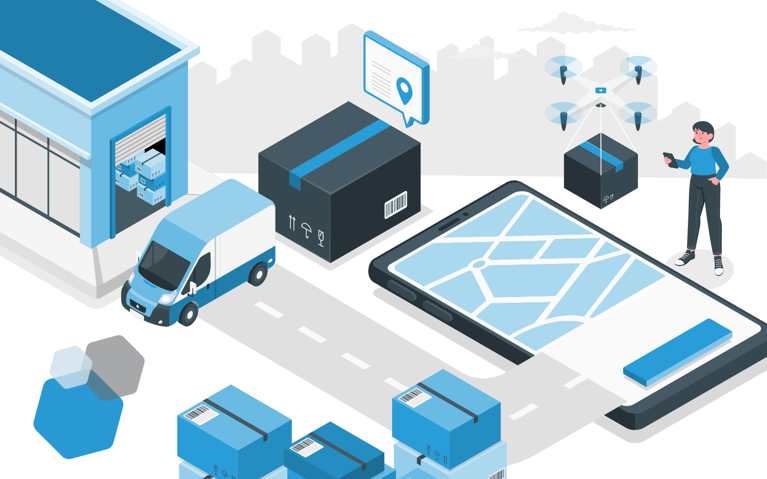Now that the holiday selling season has come to a close and sellers around the world have the opportunity to examine their brands with “2023 hindsight”, the fulfillment and delivery mistakes they made in Q4 2022 are no doubt top of mind.
Moving into a new year, the answer to questions like “how much do I need?” vs. “how much do I have?” may seem simple, but when you’re acquiring products from across the planet, selling them on potentially thousands of channels and delivering to millions of customers everywhere, things get a bit more complicated.
If you’re like most brands, you likely experienced some or all of the following fulfillment mishaps in attempting to answer questions like these … but never fear, we’re here to make sure you don’t repeat history this year. These are my expert recommendations to solve your fulfillment woes in 2023 and beyond:
1. Trouble retaining and managing a seasonal workforce
Seasonal hiring almost always presents a last-minute problem for brands of all sizes. Hiring temporary workers can negatively impact efficiency in warehouses and distribution centers, disrupt processes already in place and affect the productivity of employee KPIs like units packed per hour. Not to mention the shrinkage holiday madness is sure to bring on, and the typical lack of loyalty (or conscientiousness) from holiday workers who don’t plan on sticking around.
How to fix it in 2023: Start earlier in your holiday hiring process. If seasonal workers have a chance to feel like “part of the family”, get proper training and learn your fulfillment processes before the holiday rush, chances are there will be fewer mistakes, less shrinkage and greater efficiency when things get crazy.
And, if you reward these seasonal employees with proper onboarding, perks and personalized attention (aka the things all employees deserve anyway), it’ll be easier to convert them into full-time employees who will stick around until the next holiday season. In short, don’t treat temp workers like they’re any less important than your CEO.
2. Lack of transparency and visibility across systems
If you have no idea about the status of your orders, where your inventory is or how it’s historically sold and shipped from across selling channels, it’s almost impossible to avoid overstocks, out-of-stocks, shrinkage and late deliveries. And if customers see that your products are out of stock, on delay or arrive later than expected, you can bet your bottom dollar they won’t be back—especially if these mishaps interfere with their holiday plans.
To illustrate the point: You can't sell one inventory unit across 5,000 marketplaces, because what if 5,000 people buy that piece of inventory all at once? You’ll have 4,999 angry shoppers on your hands. To succeed in an omnichannel selling environment, brands must be able to support the inventory management it requires on the backend.
How to fix it in 2023: To make logical, profitable decisions about inventory, brands must employ solutions that provide granular visibility into their inventory’s five Ws: who, what, when, where and why. Synchronization across selling channels is key, and less complicated than you may think with fulfillment tools and technology that do the heavy lifting for you. My recommendation is obviously Cart Fulfillment, which helps brands track and sync every order from start to finish (including returns).
3. Inability to standardize product delivery across channels
Thanks to changes in iOS data sharing and today’s inflationary economy, direct-to-consumer brands have been feeling the pain of rising customer acquisition costs for some time. These days, selling your product on a DTC website is hardly profitable, and honestly, it’s an outdated business model.
I know what you’re thinking. Just list and sell your products in more places. But the trouble with selling across tens, hundreds or even thousands of selling channels and marketplaces is that each one of them requires sellers to match their own unique criteria to place and promote them. So as CAC gets higher and brands fight to price and ship their products competitively across thousands of advertising channels and marketplaces, running a profitable ecommerce business has become more tedious and expensive than ever. Or has it?
How to fix it in 2023: All aboard the automation station. If you want to sell more products in more places (and not have to manually update every product listing in your catalog to match every marketplace’s standards), try a marketplace management solution like Cart Channels.
This kind of technology automatically standardizes your product listings, ensuring every product in your catalog meets compliance standards across the world’s leading marketplaces and syncs inventory across every channel you sell on—all from one intuitive, easy-to-use dashboard. That means you can save time, sell more everywhere and standardize delivery in one fell swoop.
4. Too much inventory going into 2023
Historically speaking, product typically lands at a brand’s warehouse in September to fulfill upcoming Black Friday orders. But with what are now years-long supply chain fears looming, many brands stocked up on holiday inventory for the 2022 season as early as May—which left them vulnerable to overstocks and product expiry heading into Q1 of 2023. Not only are they paying for long-term storage on all that inventory, but it may be unsellable as seasons change in a softening economy. Think: trying to unload a million down coats or Christmas decorations in June.
How to fix it in 2023: The goal is to get in front of every consumer – regardless of channel – to create sales opportunities and heighten brand recognition. To get more eyes on your products, it’s imperative to seek out partners and channels that can help you reach more consumers than you do today. Look for opportunities to drop ship with retailers, or start selling on large marketplaces such as Amazon, Walmart and Google Shopping. Already there? Time to look for a partner who can help you optimize your entire product catalog across all of them.
5. Inventory analysis paralysis
On the flip side of my last point, sellers who chose not to stock up in spring for the holiday rush managed to avoid buying their way into inventory overload; but if brands are waiting until next year to see how much product they’ll really need in Q1, their indecision could be just as catastrophic to profits. Why?
Unfortunately, marketplace uncertainty doesn’t preclude brands from needing to forecast and order inventory before year’s end. Unless you’ve got domestic production with just-in-time capabilities, chances are you typically order inventory that’s produced and shipped from overseas – namely from China. But with Chinese New Year starting in January, many of Asia’s factories are about to come to a stand still. So if you don't have product shipped out of China before the end of December or at least early January, it likely won't ship out until mid-February—meaning you won’t receive it until April or May. That’s a lot of lost sales.
How to fix it in 2023: Of course, diversifying production of your products outside of China would thwart a lot of these issues. I know, easier said than done. But if that’s not an option for you, technology can help solve some of your “new year, new inventory” woes. While a lot of brands trust their gut or historical decision-making to make calls about their inventory, there’s a smarter approach that can mitigate a LOT of risk for your business: Demand forecasting.
Cart's Demand Forecasting algorithm ingests brands' storefront and marketing data to create daily, weekly and monthly sales forecasts for each SKU in a product catalog. Equipped with these forecasts, brands can dynamically adjust inventory orders to optimize margins all year long.
6. The perfect storm for returns
Until mid-December, everyone’s eyes are squarely focused on outbound orders. After that, the focus begins to shift to returns. And as consumers now buy more online for ease of purchase, return rates are increasing and adding to excess inventory problems for brands. When shoppers do make returns, they don’t really care about your internal processes, they just want their money back, fast – and the credit cant occur until the product is processed at your warehouse. Excess inventory, seasonal workers to process it, extra speed required. Some brands have already given up the fight - just telling customers to keep their orders and refunding them anyway. No pressure.
How to fix it in 2023: First of all, make seasonal staffing decisions based on historical data (you know your typical return rate so staff accordingly) and be sure to cross-train that staff on inbound and outbound order processing ahead of time. Now, do your due diligence to minimize returns on the front end. How? Add features to your website or marketplace listings that let shoppers “try before they buy” (think AR that lets them see a 3D image of furniture in their room). Ask what size they wear in other brands to determine the best fit in yours. Make the experience more tailored and data-driven upfront to ensure you don't get a huge flush of inventory back on the floor come January.
Don’t let the perfect be the enemy of the good
I’d wager that after any holiday season, virtually no one is 100% satisfied with their 3PL provider. Why? When it comes to running an ecommerce business, especially in this environment, sh*t happens – and anyone who says differently is either lying or selling something (any The Princess Bride fans out there?).
The 3PL industry is not so much about mitigating all the issues that can arise, but instead about managing those issues when they do. So don’t just look at price as the deciding factor on choosing a logistics partner. Ask questions like this to find a partner that’ll move your business forward, even when things go wrong:
- When you didn't hit all your SLAs, what did you do?
- What technology do you have in place to ensure inventory accuracy?
- What are the proactive steps you take with customers today to assist in their businesses?
By acknowledging that things don’t always go right, you’re much more likely to get through the hard stuff with a fulfillment partner that knows how to navigate rough waters.





